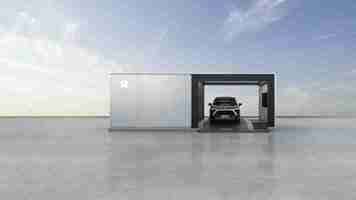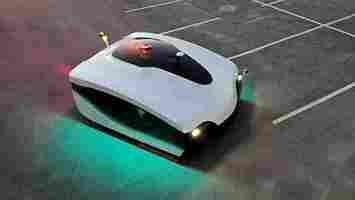Can EV battery swap stations really go mainstream?
Let’s face it: wrapping your head around EV charging infrastructure can be confusing. And actually waiting while your car gets filled with juice? No thanks.

But what if you didn’t have to charge your vehicle at all? What if there was another way? And what if that way was battery swap stations?
Way back in 2013, Tesla proposed the idea of a 90-second battery swap shop . Two years later, Tesla quit the effort. It switched its strategy, focused on the Supercharger network, and declared that battery swapping was a dead-end.
But is it really? Let’s dig in.
The idea is simple. You drive up to a car wash-sized station and you hand your vehicle over to the valet — or even stay inside. The workers and/or the machines do the rest: bolts are unscrewed, the battery is removed, a new one is replaced, and everything is reassembled.
That sounds like it should take forever, right? But based on the swap stations we have so far, the whole process only takes one to three minutes (more on that later). That’s a full ‘charge’ in less time than it takes to drink an espresso.
Besides saving time, you’d also save money. The cost of the car can be separated from the cost of the battery pack, making EVs more affordable for some drivers.
Plus, you wouldn’t have to worry about battery degradation or warranties. And your vehicle could have a longer life if it’s not attached to its battery. Remember, it’s the batteries that have an expiration date, not the car itself.
Similarly, swapping makes it possible to always have the latest battery tech installed in your vehicle.
For starters, manufacturers would need to produce compatible batteries for all brands. This means that the battery pack would need a very specific universal design.
What’s more, we’d need a greater number of batteries to power the same number of EVs. Not to mention the changes required for an entirely new infrastructure.
Battery swap stations seem to be picking up pace in China, at least.
In December, NIO reached 700 stations across the country, having provided 5.3 million swaps to NIO car owners. Its swap stations are fully automated and can do the job in three minutes.


Last week, CATL — you know, China’s biggest battery manufacturer — announced the installation of its EVOGO swaps stations across 10 Chinese cities.
The company says its new modular battery blocks are compatible with 80% of the global platform-based EV models, but for now the first car to make use of the EVOGO service will be the Bestune Nat MPV built by FAW Group — one of CATL’s partners.
Notably, the EVOGO stations can swap the batteries in only one minute.
The same swapping time is also promised by Geely, which is planning to set up 5,000 stations across China by 2025.
In January, NIO launched in Norway Europe’s first battery swap station , intending to expand in Germany as well.
In the US, Ample has launched five initial stations in San Francisco, and has partnered up with Uber and Sally for its swapping services.
It plans to expand to other US cities, Europe, and Japan.
Maybe in some parts of the world, or well, China.
Apart from an increasing number of companies that are betting on the tech, the Chinese government is also backing battery swapping.
It’s introduced its own battery swapping program , it has approved national EV battery swap standards , and the State Grid (the state-owned electric utility corporation) has struck partnerships with multiple major players for the development of battery swap stations.
That’s not really surprising: China is the word’s biggest EV market, its technological pace is faster, and its car industry might be able to make progress where others have failed.
But that’s not the case for western countries.
The EV market is only now starting to catch up — and, along with it, conventional charging infrastructure.
It’d be a huge ask for governments to back another charging alternative, and it’d be an even bigger ask for automakers to start using a universal, standardized battery pack.
I seriously doubt that car companies would ever be convinced to tear up existing and future product plans, and start from scratch.
Then again, charging station infrastructure was addressed with skepticism in its beginning as well, so perhaps we need more time to really assess how battery swap stations will be received.
But even if they take off, my guess is that they won’t replace good ol’ chargers. At best, they’ll coexist.
Say ‘hei’ to Trombia, the robot cleaning up Helsinki’s streets
This article was originally published by Sarah Wray on Cities Today , the leading news platform on urban mobility and innovation, reaching an international audience of city leaders. For the latest updates follow Cities Today on Twitter , Facebook , LinkedIn , Instagram , and YouTube , or sign up for Cities Today News.

The City of Helsinki is trialing a quiet, emission-free robot in a bid to find new ways to keep streets clean with minimal disruption to residents.
The Trombia Free vehicle will run from today until April 27 on weekday evenings on a busy street (Välimerenkatu) and bicycle path (Baana) in the Jätkäsaari area of Helsinki.
“The autonomous and electric street sweeper is so quiet that it makes it possible to sweep the streets at night, hindering traffic as little as possible,” said Antti Nikkanen, Managing Director, Trombia Technologies. “For us, Jätkäsaari is an ideal smart city test location and a reference for the world’s major cities, as Jätkäsaari at night will show what can really be achieved with automation in an urban environment.”
In particular, the pilot will monitor the noise level and efficiency of the street sweeper as well as broader benefits and limitations. The machine can detect obstacles and pedestrians in its path and stop, but during the pilot it will always be accompanied by an operator.
Mobility testbed
The trial is part of the Jätkäsaari smart mobility testbed .
Janne Rinne, Project Manager, Forum Virium Helsinki, the city’s innovation unit, said: “Our goal is for the best solutions to be exported from Jätkäsaari Mobility Lab to other cities in Finland and abroad. At the same time, we are promoting Helsinki’s climate goals and creating a more enjoyable urban environment for the residents.”
Trombia Free is described as “the world’s first fully powered, electric and autonomous street sweeper”. Trombia says the device consumes only 15 percent of the energy and a fraction of the water of conventional cleaning machines and does not generate emissions.
The City of Espoo is also trialing the Trombia Free.
Do EVs excite your electrons? Do ebikes get your wheels spinning? Do self-driving cars get you all charged up?
Then you need the weekly SHIFT newsletter in your life. Click here to sign up .
How escooter firms Dott, Lime, and Tier got to stay in Paris
Winning what some called the “world’s biggest e-scooter tender,” the electric scooter players Lime, Dott, and Tier were selected on July 23, 2020 as the three operators authorized to remain in the city of Paris for the next two years. In a metropolis that became quintessential of the ‘trottinette takeover,’ — at one point flooded by more than 20,000 e-scooters from over a dozen companies — this highly competitive Request For Proposal (RFP) represents the growing trend of cities adopting stricter regulations to more firmly control the implementation of free-floating and micromobility solutions on their streets.

The winning operators were ultimately selected according to three key criteria: environmental responsibility, user safety, and operations management, maintenance, and charging. As other European cities follow suit with RFPs that are judging respondents on very similar measures, here is a look at the importance of each criterion as well as a first-hand account from Lime, Dott, and Tier on why their bids stood out from those of the competition.
Environmental responsibility
With a 40% weight in the decision, operators’ measures to implement sustainable and environmentally responsible business practices was the most important factor in the Paris tender’s final selection. While, according to Bloomberg New Energy Finance, emissions from electric scooters can be up to 20 times lower than those of an electric car and several hundred times lower than those of an internal combustion engine (ICE) car, emissions associated with scooter manufacturing and lifetimes, charging, and collection/redistribution can significantly alter the overall reduction in emissions that electric scooters can offer. “Like any object produced, the scooter has an ecological cost. This new industry has to continually strive for improvements, and this is why we work every day to reduce the carbon footprint of our machines and our business” says Nicolas Gorse, General Manager of Dott France.
For the winners of the Paris tender, each expressed that environmental responsibility was fundamental to their mission and success. Out of these three operators, all have implemented 100% electric fleets for operations and maintenance, swappable batteries for all new scooter models, and various programs such as Tier’s MyTier , Dott’s commitment to reusing or recycling all possible parts, or Lime’s participation in the CarbonNeutral Protocol . For Garance Lefevre, Director of Public Policy France & Benelux for Lime, “Sustainability cannot just be used as a marketing tool to win RFPs. It must be why an operator is in business and core to their vision.” The next big step should be for all operators to supply 100% of their operations with renewable energy.
User safety
According to a study conducted by the University of California – San Francisco , researchers found that the number of scooter-related injuries and hospitalizations had increased by over 200% in the United States between the years 2014 – 2018. While the International Transport Forum concluded that e-scooters were no more dangerous than cycles (and in fact a trip by a car or motorcycle in a dense urban setting was more likely to result in a fatality), there were recommendations to implement stronger regulations at the city, manufacturing, and operating levels. For the three winning Paris operators, riders’ physical safety must be managed on two levels: scooter hardware and public education. Following safety-by-design principles, specifications like suspension systems, wider decks that optimize gravity, and, in Tier’s case, even the new provision of a helmet box, these stand out as important factors that help to prioritize user safety on the vehicle itself.
In addition, each operator has taken initiatives to educate their riders on safe riding behavior and practices, whether through their online app , establishing a safety advisory board , or regular onsite demos and training . In terms of what cities are looking for, “The criteria are sometimes different from one city to another, but for us, sustainability and safety are the most important criteria” says Gorse. Additional criteria regarding user safety included data protection and insurance, of which each operator has implemented measures for both.
Operations management, maintenance, and charging
Finally, when looking at operations management, maintenance, and charging of their fleets, a strong focus was placed on the equitable geographical distribution of e-scooters throughout Paris. This principle will be closely connected to the capacity of staff and operations, and the winners were judged on their ability to manage the maintenance, removal, and stationing of e-scooters in designated public areas effectively. For Alexandre Souter, General Director, France for Tier, this means that “Our operations are effective because they are done totally internally. This means we can quickly collect our damaged scooters everyday so they can be fixed and deployed within 48 hours.” For Lime and Dott, using skilled, in-house professional teams is also essential for achieving operational excellence and meeting social responsibility expectations. On why he thinks operations must not be overlooked, Souter explains, “Operational excellence is a key factor in being successful. We work everyday to improve our daily management, to collect our damaged scooters faster, to respect the public space. Our mission is to offer more sustainable mobility, and it truly starts at the operations level.”
Ultimately, when asked to give advice to other mobility companies working towards highly competitive RFPs, the winning operator’s responses were concise but powerful. The final word? Walk the talk, work in total transparency with communities, and address top concerns with a tailored, highly localized proposal that shows cities you are a partner with which they can trust and work within the long-run.
This article was written by Rebecca Sands on The Urban Mobility Daily , the content site of the Urban Mobility Company, a Paris-based company which is moving the business of mobility forward through physical and virtual events and services. Join their community of 10K+ global mobility professionals by signing up for the Urban Mobility Weekly newsletter . Read the original article here and follow them on Linkedin and Twitter .

SHIFT is brought to you by Polestar. It’s time to accelerate the shift to sustainable mobility. That is why Polestar combines electric driving with cutting-edge design and thrilling performance. Find out how .